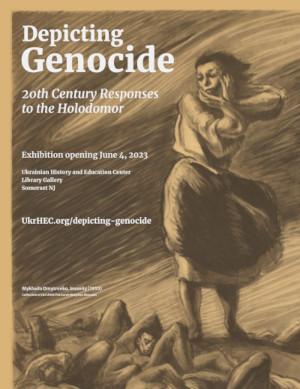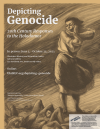Posted on July 25, 2023

Ninety years ago, millions of people died of starvation in Ukraine as a result of intentional genocidal actions by the Stalin regime. The Holodomor (from the Ukrainian: "Killing by famine") was part of a broad campaign in the late 1920s and 1930s that attempted to quash any residue of Ukrainian autonomy and self-determination by attacking the deepest sources of that identity: language, culture, and traditions centered on agriculture and the land. The Ukrainian History and Education Center's newest exhibition "Depicting Genocide" explores some of the ways in which the Holodomor was represented during the 20th century, particularly though art. The UHEC is honored to have a number of major Holodomor-related artworks in its permanent collection, and this exhibition is built around them. It explores the extremely varied styles and approaches that artists over more than seven decades have taken to engage with this tragedy.
Unfortunately, Moscow is again perpetrating genocide in its war of aggression against Ukraine. While history does not repeat itself, the echoes can be quite striking. Just as Russians must speak of a "special military operation", people in the Soviet Union had to speak of "food difficulties" regarding the events of 1932-1933. Just as the Kremlin is claiming that the Ukrainian government is destroying its own cities and killing its own citizens, 90 years ago Stalin insisted that farmers were purposely starving themselves to sabotage Soviet agricultural progress. Just as Moscow and its supporters tried to discredit those speaking and writing about the Holodomor by calling them “fascists”, Russia today tries to discredit the democratically elected government of Ukraine by calling it a “Nazi junta”. And just as the Holodomor involved cultural genocide in addition to human death, so has the Russian invasion of Ukraine resulted in the looting and destruction of museums, libraries, archaeological sites, and other locations of cultural importance.
Perhaps even more concerning is that Moscow is again using food as a weapon, with Russian state-controlled media pundits openly “hoping for a famine”. Not only is Russia threatening grain shipping on the Black Sea, it is also destroying grain warehouses and port facilities on the Black Sea and the Danube. This is not just a Ukrainian problem: it is already upending grain markets and will threaten the Global South and other parts of the world with increased food insecurity and hunger. And this does not include the longer-term consequences such as the ecocide from the destruction of the Kakhovka dam and the massive quantities of land mines now strewn over the grain fields of southern Ukraine.
The in-person version of this exhibition which opened on June 4, 2023 at the UHEC Library Gallery is now complemented by a full-scale online counterpart. There you will find not only reproductions of the items on display in the physical exhibition, but also more extensive historical and cultural context on the Holodomor and its impact both in Ukraine and in the United States. If you are able to visit the UHEC in Somerset, New Jersey, then we urge you to do so. Photographic reproductions are not a substitute for seeing the actual objects in-person. A number of the works in this exhibition are monumental in scale, and some are very difficult or impossible to fully convey in a photograph. Hours are generally 9am-5pm on weekdays (except for holidays) or by appointment, and directions are available on the UHEC website.

The "Depicting Genocide" exhibition and associated programming and content is made possible by a grant from the New Jersey Council for the Humanities, a state partner of the National Endowment for the Humanities. Any views, findings, conclusions, or recommendations expressed in this exhibition do not necessarily represent those of the National Endowment for the Humanities or the New Jersey Council for the Humanities.

